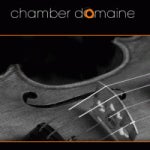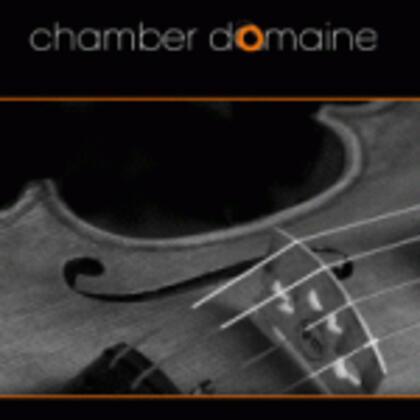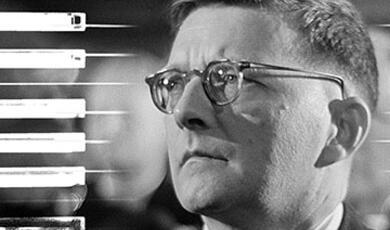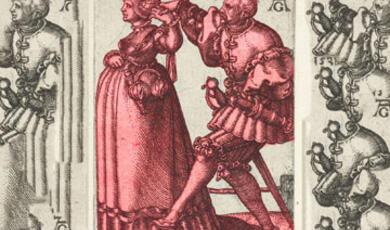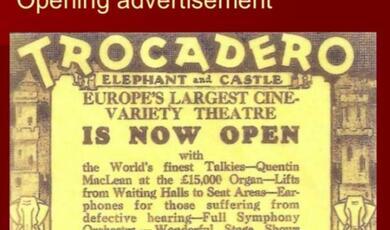Mahler and Schoenberg
Share
- Details
- Text
- Audio
- Downloads
- Extra Reading
Mahler was a huge inspiration for Schoenberg and an early champion of his music. We will explore the influence Mahler had on Schoenberg and the Second Viennese School, and the arrangements of Mahler for the Private Music Society, at the cutting edge of music from 1918-21.
Concert: Mahler, Kindertontenlieder: Webern, Concerto for Nine Instruments, Op.24; Berg, Piano Sonata Op.1; Schoenberg, Five Pieces for Orchestra, Op.16.
Download Text
16 December 2010
Mahler and Schoenberg
Chamber Domaine
Welcome everybody.
Today’s concert does not feature any Schoenberg, but my lecture concerns Schoenberg and Mahler, and Mahler’s influence on the Second Viennese School. Much of today’s programme comprises Second Viennese School music by Berg and Webern, as well as the wonderful settings of Rückert’s Kindertotenlieder, which Mahler completed in 1904.
Between 1900 and 1910, Schoenberg wrote Gurre-Lieder, a piece that represented something of a synthesis of the two polemics that dominated German music in the 19th Century: the ideas of Brahms, particularly with regard to harmonic rhythm and structure, with the musical aesthetic and language of Wagner. It is a hugely influential work. It was incredibly popular. At the first performance, he received a fifteen minute ovation, which was very unusual for Schoenberg. But this is an interesting piece because, by the time Schoenberg had completed it (he actually finished the orchestration in 1911), he had moved so far away from its origins in 1900 that he actually hated the performance, even although it was a great success. The crowds were hysterical, shouting and cheering. He refused to bow to the audience. He only bowed to the orchestra. Many of his friends thought he was actually insane because he obviously did not realise the significance of what he had done. Many of his performances between writing this piece and its premiere in 1913 had often caused riots. In fact, Mahler, who was a great supporter of Schoenberg, had to be restrained by the police for trying to thump a heckler at the premiere of Schoenberg’s first string quartet in 1907. Schoenberg was the bête noire of music in Vienna at that time. Mahler very much appreciated his ability and talent and supported him financially, as well as championing his cause.
Schoenberg, on the other hand, only really began to realise the significance of Mahler’s music when he heard a performance of the Third Symphony; his enjoyment of Mahler is reflected in Gurre-Lieder. I think Schoenberg learned a lot from him, particularly with regards to orchestration and balancing instruments and being able to use very spare lines, single lines, very simple accompaniments. In the Webern featured in today’s programme, the influence of Mahler really comes into play – especially considering the spareness of Das Lied von der Erde or the finale of the Fourth Symphony. However, because of other issues, it does not sound very much like Mahler, but I shall come to that later.
Mahler really supported Schoenberg, physically, financially, but also spiritually. Mahler encouraged Schoenberg to keep going, which was important for Schoenberg, because Mahler was probably the most famous Viennese/Austrian musician of his day.
I would like you to now listen to an extract from Gurre-Lieder. This piece was premiered with Franz Schreker conducting, and it has a Wagnerian plot. It is based on a Danish tale about a king who murders his wife and ends up with his lover. It is a distinctly Wagnerian topic, a little bit like Tristan and Isolde. This is the very beginning of the piece, which we shall come back to at the end of this lecture.
[Music plays]
It is fantastic music! It is very much of its time, late-Romantic in style. The rest of Gurre-Lieder moves away from this kind of Romanticism. Indeed, in the third act of this piece, Schoenberg uses sprechstimme, which is speech melody, and a great feature of his revolutionary piece, Pierrot Lunaire (1912). It is an incredible piece. It is a culmination of an entire century of Romantic ideas. One of the things that Mahler and Schoenberg had in common was a belief that Austro-German music was, spiritually and philosophically, the greatest music in the world. Indeed, when, in 1910, Schoenberg wrote his famous book, Harmonielehre (Theory of Harmony), he told a friend that he was the musical equivalent of Albert Einstein, because his ideas would transform the history of music. He said, “It will make German music the greatest music for another 100 years.” Both Mahler and Schoenberg think that their music is something really special and for everybody, but it comes from a Germanic Romantic tradition that really starts with Beethoven – in particular, Beethoven’s Ninth Symphony.
Schoenberg is really the person – and Mahler recognised this – that brought together the two conflicting poles of the German tradition: the Brahmsian side (academic, structured, baroque, a feeling for harmonic rhythm) with the Wagnerian side (philosophy, psychological torment, very short, light motifs strung out over unheard of lengths of time).
It is important to see this musical tradition, at the beginning of the 20th Century, in terms of nationalism. As I said in my previous talk, the Austro-Hungarian Empire was the second biggest land mass in Europe, second only to Russia. People really felt they were part of an enormous cultural unit, and when you add Germany, you are talking about an even greater philosophical unit. It is important to take this into consideration when listening to this music, because this is not just a matter of chromatic scales, which I shall talk about in a minute; it is also about a philosophy underpinning the whole period since Beethoven, through to the time we are talking about now, with Mahler, Schoenberg, Berg, Webern.
When Mahler died in 1911, Strauss wrote to Alma Mahler: “The only person that can help Schoenberg now is a psychiatrist.” Strauss, who had started out as a very revolutionary, modernist composer with his operas Elektra and Salome, ultimately became a neoclassical, late-Romantic composer (albeit a glorious one), and he basically maintained that style throughout the rest of his life, from 1907/08 onwards. Schoenberg, on the other hand, went in a completely different direction. I shall now talk about why this is special, what makes it different to other music.
I would like to welcome three of our musicians: Anna, on the flute, Matthew Ward, playing the violin, and Bruce, on the trumpet.
This is a bit like going back to school in the 1960s. They probably do not teach notes in most schools these days. Here we have a chromatic scale, with all the notes numbered, one to twelve.
[Musician plays]
Could you play that on the flute, backwards?
[Musician plays]
Schoenberg wanted to move away from conventional harmony, i.e. harmony based around tonal centres, like C Major or G Minor. Brahms and all the composers before him were very much in this mould. He tried to create a method in Harmonielehre where each of these pitches is equal. This is incredibly democratic for notes, but not so much for players because this music is very hard!
Schoenberg said that you could order any of these notes, up to twelve, in any order. As it is Christmas, we are going to do a Gresham tone row. Would someone please call out a number?
Audience Member: Seven.
Number seven is an F Sharp… Next?
Audience Member: Three.
Three is D… Next?
Audience Member: Nine.
Nine, G Sharp… Next one?
Audience Member: One.
A nice C for number one… Next one?
Audience Member: Five.
We have got an E at five. Next?
Audience Member: Eight.
G natural at eight. Next one?
Audience Member: Ten.
Ten is an A. Next one?
Audience Member: Twelve.
We have got a B natural at twelve. Next one?
Audience Member: Eleven.
Eleven is A Sharp.
Audience Member: Two.
C Sharp.
Audience Member: Four.
And four, we have got a D Sharp. Great. This is what Schoenberg called a tone row. Anna, could you play that on the flute?
[Musician plays]
Marvellous! Very well done – a great composition!
Now, if we do this backwards, it is called a retrograde...
[Musician plays]
Bruce, do you think you could do an inversion? We have done the tone row, and we have done it backwards, but there are two other versions. Basically, instead of going down a major third, from F Sharp to D, you go up a major third from F Sharp to A - everything is kind of in reverse. Do you think you can do it? Have a go!
[Musician plays]
Bruce: No – I can’t do it!
Well, that is actually what most people felt when they first saw this music on the page!
So, you have four versions of this row. This is a very simplified version of how these composers composed. To give you an example, in Webern’s Opus 24, written for Schoenberg’s 60th birthday, he put these groups of notes into groups of three notes. This gives you four different sets of notes within the twelve notes, and you have a minor third and a minor second in each group of notes. Webern thus creates something like a grid, enabling you to do retrogrades, retrograde inversions, inversions of the theme; you can take these groups of three notes and turn them into a single motif. It is not dissimilar to what Beethoven does in the Fifth Symphony, or what Brahms does in the Second Symphony, where you start with maybe two ideas in the opening two bars, and these preoccupy the whole piece. The difference is this does not sound so tonal, although most of the composers that you will hear today use this not just for making things as dissonant as possible, but also with the possibility for consonance and harmony.
We are now going to take our piece and add some articulation and dynamics. Anna, could you make this a happy motif? Shall we do it fast and short, or long and sustained? Let’s have long and sustained for the flute.
Then we shall take these three notes, which happen to be C Major – Bruce, maybe you could do that bit, and the retrograde?
Any takers for that nice C Major triad?
Audience Member: Angry.
What has it ever done to you? Okay, we shall make it angry. That is Bruce, on the trumpet. What about a dynamic? Angry? Strong? Yeah! Fortissimo!
How about the violin?
Audience Member: Triumphant.
Triumphant – great! Actually, we shall make this more and more triumphant as it goes along. We shall start sad and build to triumphant.
Now, in this tradition of music, this can become like a motivic cell: any of these things can be, but you cannot repeat notes once you have played them. So, you could not do F Sharp and a D and then another F Sharp. You could do a thousand notes on F Sharp and one on D, but you cannot go back.
We are now going to play these three different motifs, and then we shall combine them together, so you can start to see how Schoenberg, Webern and Berg worked at their music. First, the flute: happy, long and sustained.
[Musician plays]
Bruce?
[Musician plays]
Marvellous! A round of applause for that!
[Applause]
We shall now overlap these elements, and see how that works. If you all just come in, as and when – but just once.
[Musicians play]
You can already see that something is developing. Thank you very much – fantastic!
[Applause]
We have talked a little about the pitch structure of the Webern that you are going to hear, but in Brahms’ Fourth Symphony, we have this melody [sings]: a beautiful beginning to a symphony. In the Webern second movement, we have exactly the same gesture, on the piano, but because the pitch is all arranged in this way, it is much harder to hear the connection between it and the Brahms. However, I am suggesting that you should listen to this music like it is connected to the musical past. It is not something completely abstract.
After the performance of Gurre-Lieder, Schoenberg said that he wanted to write music where the audience deliberately would not know where it had come from. This is perhaps arrogant on his part, but it is also connected to the Romantic concept of the artist being against everybody, or everyone being against the artist. This takes us back to Beethoven and people not really understanding his later music. Schoenberg felt this very keenly, and I think it is no accident that he tried to copy this idea. Mahler said, “My time will come when people will understand my symphonies.” Now, he is one of the most popular composers. In fact, I recently looked in a catalogue and saw that he has nearly as many recordings of his symphonies as Beethoven, which just about says it all.
For tonight’s repertoire, I have included the Webern cello pieces that you heard last time, partly because they are fantastic, but also because you can directly hear the difference between late-Romantic style and the three modernist pieces that follow them. You can hear a beautiful sense of line and sound in the cello pieces, written in 1899. They are like “little Lieder,” songs without words. The three small pieces following that are very tightly constructed and atmospheric. Their silences are as important as their notes. The texture of the sound, the dynamics, the gestures, are all as important as anything else. It is almost atomic in the way that it is constructed because you could not add or subtract a single note. Indeed, in the Opus 24 concerto, which will start tonight’s concert, there are only a few places where all or some of the instruments actually play together. Webern has pared down the music to its absolute minimum, so you have lots of counterpoint; there is very little confluence between the different elements vertically, but lots of confluence between motifs. It is basically an extension of the German tradition that Bach established, of fugue and counterpoint. Indeed, one of Webern’s most famous early pieces is a passacaglia, a 17th Century form, where you repeat the same base over and over again.
The Webern concerto may sound quite abstract. If you take, for example, the opening notes of our tone row… [plays] …it is totally possible. They are the same notes, but because they are played in different octaves, it is very hard to recognise that they are the same pitches. This opens up a whole new range of possibilities, exploited by these composers.
Webern had quite a sad but interesting life. He was very nationalistic. He actually wrote an article criticising the Nazis, which never got published, and it actually saved his life. Most of his music was not written to commission, he just wrote it. Opus 24 was a present to Schoenberg. He had to earn his living working for Universal Edition as an editor. His death is a tragedy, a double tragedy in fact. During the curfew in February 1945, he went outside to have a cigar, and was shot dead by an American soldier. The soldier was so traumatised when told what he had done that he became an alcoholic and died of alcohol poisoning in the early 1950s. Some wits, mainly people like Thomas Beecham, said it was “Americans’ greatest contribution to Western culture”. A comment from Stravinsky says it all:
“He was doomed to a total failure in a deaf world of ignorance and indifference. He inexorably kept on creating his dazzling diamonds, the likes of which are so perfect and show so much knowledge about music.”
He was a huge influence on many composers that followed in the post-war period, and his music is great. It is very distinctive; there is nothing else quite like it.
Mahler’s Kindertotenlieder is a very special set of songs, sung by Wendy, a fantastic mezzo-soprano. Rückert wrote 428 poems between 1833 and 1834. His two children died from scarlet fever, and he tried to recreate his children through these poems, so they are very special. When Mahler was writing these songs, between 1901 and 1904, he had just married Alma Mahler and fathered two children. He was attempting to get inside the mind of the poet when he was writing these songs, and he even wrote that he wanted to feel like his daughters had died. The tragedy was that, in 1908, his daughter actually died of scarlet fever. He said at the time he could never have written Kindertotenlieder after that. The idea of getting inside a character’s mind is quite interesting from the point of view of cultural history. Compare Mahler to the Austrian writer, Stefan Zweig, and his book Marie Antoinette, which is written in the first person. It is quite a Freudian thing to do, to actually assume the mantle of another person and try and understand their point of view, in this very profound music.
To conclude, we have here a very special concert. It is very unusual to hear to hear these works juxtaposed, but I hope you will remember the beginning of Gurre-Lieder. Schoenberg ended up in Los Angeles as a refugee; he was asked to compose a film and he never did. He lived one block away from Stravinsky. A lot of his music and ideas are misunderstood. Towards the end of his life, he started to talk about how his music related to Brahms and Schubert and the earlier composers, but I just want you to listen to these two extracts. One is the opening of Gurre-Lieder, and then the other is something that you all know and love…
[Music plays]
This event was on Thu, 16 Dec 2010
Support Gresham
Gresham College has offered an outstanding education to the public free of charge for over 400 years. Today, Gresham College plays an important role in fostering a love of learning and a greater understanding of ourselves and the world around us. Your donation will help to widen our reach and to broaden our audience, allowing more people to benefit from a high-quality education from some of the brightest minds.


 Login
Login
